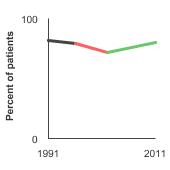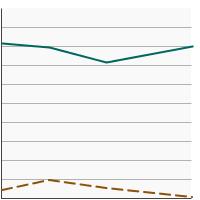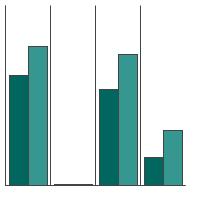On This Page:
- Background
- Measure
- Healthy People 2030 Target
- Data Source
- Trends and Most Recent Estimates
- Additional Information

Background
Ovarian cancer forms in the tissues of the ovary (one of a pair of female reproductive glands in which the ova, or eggs, are formed). Most ovarian cancers are either ovarian epithelial carcinomas (cancer that begins in the cells on the surface of the ovary) or malignant germ cell tumors (cancer that begins in egg cells). Cancerous ovarian tumors can also begin in stromal cells, which release hormones and connect the different structures of the ovaries, though this is less common. Ovarian epithelial, fallopian tube, and primary peritoneal cancers form in the same tissue and are treated the same way.
Ovarian cancer treatment varies by the type of tumor. Often, two or more different treatments are used, though surgery is the main initial treatment for most ovarian cancers. Studies in early stage ovarian cancer have shown an increase in overall survival with the administration of chemotherapy, which is used in the majority of cases as a follow-up therapy to surgery. Epithelial ovarian cancer is treated with surgery, chemotherapy, and targeted therapy. Ovarian germ cell tumors are treated with surgery, chemotherapy, and radiation therapy. Ovarian stromal tumors are treated with surgery, chemotherapy, and hormone therapy.
Guidelines suggest intraperitoneal (IP) chemotherapy for later stage ovarian cancer. IP chemotherapy involves injecting a concentrated dose of drugs through a thin tube into the abdominal cavity where the cancer cells are located. In a study of women with advanced ovarian cancer, those receiving IP chemotherapy lived longer than those getting regular chemotherapy, but the side effects of IP chemotherapy were often more severe.
Measure
Data Source
SEER Patterns of Care/Quality of Care Studies, National Cancer Institute,1991-2011.
Healthy People 2030 Target
- There are no Healthy People 2030 targets for cancer treatment, including ovarian cancer treatment.
Healthy People 2030 is a set of goals set forth by the Department of Health and Human Services.
Trends and Most Recent Estimates
- Stage I and II Diagnoses
-
Percent of patients aged 20 years and older diagnosed with stage I or II ovarian cancer by type of treatment received, 1991-2011 Overview Graph Detailed Trend Graphs Most Recent Estimates (2011) Percent of patients 95% Confidence Interval 

Chemotherapy 
63.5 59.4 - 67.3 Hormone therapy 
0.7 0.3 - 1.5 - Stage III and IV Diagnoses
-
Percent of patients aged 20 years and older diagnosed with stage III or IV ovarian cancer by type of treatment received, 1991-2011 Overview Graph Detailed Trend Graphs Most Recent Estimates (2011) Percent of patients 95% Confidence Interval 

Chemotherapy 
79.9 77.0 - 82.4 Hormone therapy 
0.6 0.3 - 1.2 - Distribution of Chemotherapeutic Agents
-
Distribution of chemotherapeutic agents given to ovarian cancer patients aged 20 years and older by type of treatment received, 2011 Overview graph Chemotherapy agent received Stage I and II Stage III and IV Percent of patients receiving agent Confidence Interval Percent of patients receiving agent Confidence Interval 

Carboplatin/Cisplatin 61.1 56.9 - 65.1 77.5 74.5 - 80.2 Cyclophosphamide (Cytoxan) 0.1 0.0 - 0.4 0.6 0.3 - 1.0 Paclitaxol (Taxol) 53.3 49.2 - 57.5 72.6 69.5 - 75.4 Other Chemo Agents 15.7 12.9 - 19.1 30.7 27.7 - 34.0
Additional Information
- Ovarian, Fallopian Tube, and Primary Peritoneal Cancer. National Cancer Institute.
- Ovarian, Fallopian Tube, and Primary Peritoneal Cancer Treatment (PDQ®)-Patient Version. National Cancer Institute.
- Ovarian Germ Cell Tumors Treatment (PDQ®)–Patient Version. National Cancer Institute.
- Ovarian Low Malignant Potential Tumors Treatment (PDQ®)–Patient Version. National Cancer Institute.
- Treating Ovarian Cancer. American Cancer Society.
- Ovarian Cancer (NCCN Guidelines for Patients®). National Comprehensive Cancer Network.
- Ovarian Epithelial, Fallopian Tube, and Primary Peritoneal Cancer Treatment (PDQ®)-Health Professional Version. National Cancer Institute.
- Ovarian Germ Cell Tumors Treatment (PDQ®)-Health Professional Version. National Cancer Institute.
- Ovarian Low Malignant Potential Tumors Treatment (PDQ®)-Health Professional Version. National Cancer Institute.
- SEER Cancer Stat Facts: Ovarian Cancer. National Cancer Institute.
- SEER-Medicare Linked Database. National Cancer Institute.
- SEER Patterns of Care/Quality of Care Studies. National Cancer Institute.